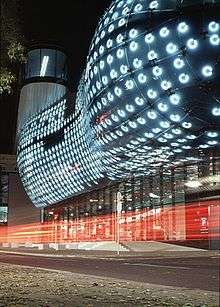Kunsthaus Graz


The Kunsthaus Graz, Grazer Kunsthaus, or Graz Art Museum was built as part of the European Capital of Culture celebrations in 2003 and has since become an architectural landmark in Graz, Austria. Its exhibition program specializes in contemporary art of the last four decades.
Architecture
Its unusual form differs radically from conventional exhibition contexts, many of which maintain the traditions of the modernist "White Cube". The team of architects used an innovative stylistic idiom, known as blob architecture within the historical ambiance of the Murvorstadt. Thus, the gigantic building affectionately called the "Friendly Alien" by its creators Colin Fournier as the Partner-in-Charge together with Peter Cook, in form and material, stands out consciously against the surrounding baroque roof landscape with its red clay roofing tiles but nevertheless integrates the façade of the 1847 iron house. It has an organic shape with a skin made of iridescent blue acrylic panels.
Concept
Architecture, design, new media, internet art, film, and photography are united under one roof. Kunsthaus Graz was developed as an institution to stage international exhibitions of multidisciplinary, modern and contemporary art from the 1960s to the present day. It doesn't collect, maintains no permanent exhibitions, has no permanent depot at its disposal and no research establishments. Its exclusive purpose is to present and procure contemporary art productions. Kunsthaus Graz implements an innovative concept, which offers various possibilities in its galleries to fulfill the high curatorial requirements of contemporary exhibitions.
BIX Façade

The BIX Façade of the museum represents a singular fusion from architecture and New Media and is based on a concept of the Berliner architects realities:united. BIX, a name which consists of the words "Big" and "pixels" is the acrylic glass skin of the eastern side of the building toward the Mur and city center and represents an oversize urban screen, which serves as an instrument for artistic productions. BIX projects accompany different exhibitions and are not transported into the public area, also the direct environment is defined and shaped. Beyond that the "communicating outer skin" offers also a possible drilling platform for art projects, which bring up for discussion the dialogue between media and area. 930 40 Watt fluorescent rings are embedded in the 900 m² outer skin, with the illumination level of each one being steplessly variable between 0 and 100%. Each light ring functions as a pixel, which can be served by a central computer. In this way they can be developed as roughly screened indications, texts and film sequences, which radiate far into the urban area and thus, the blue blister of Graz with a screen of immense size makes an art gallery.
References
- Cook, Peter & Fournier, Colin. A Friendly Alien: Ein Kunsthaus fur Graz. Hatje Cantz Publishers. September 30, 2004. ISBN 3-7757-1350-6
External links
| Wikimedia Commons has media related to Kunsthaus Graz. |
- (German) Kunsthaus Graz
- (German) BIX Medienfassade
Coordinates: 47°4′17.1″N 15°26′2.6″E / 47.071417°N 15.434056°E